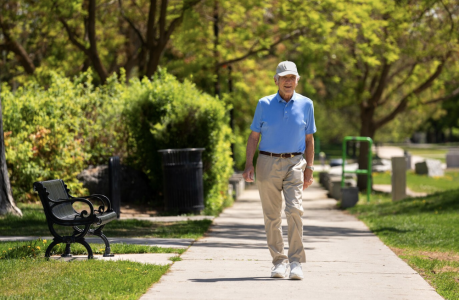Study reveals simple exercise that may significantly lower the risk of type 2 diabetes
By
VanessaC
- Replies 4
Disclaimer: This article cannot be considered medical advice. Remember to consult with your doctor before starting any fitness regimen.
Type 2 diabetes is a global health concern that has seen a significant rise in prevalence over the past three decades.
According to the World Health Organization, over 537 million people worldwide have been diagnosed with this condition, and it is a leading cause of severe health complications such as blindness, kidney failure, heart attacks, stroke, and lower limb amputation.
However, a recent global study has revealed the simple yet effective key to significantly lower the risk of developing this disease.
The key? Walking faster.
Walking has long been associated with a lower risk of type 2 diabetes, but until now, the optimal walking speed for reducing this risk remained unclear.
A new worldwide analysis of studies, published online in the British Journal of Sports Medicine, has shed light on this matter.
The study found that people who walked faster than 3km/h were less likely to develop type 2 diabetes, and those who walked at a brisk pace of more than 6km/h lowered their risk by a whopping 39 per cent.
The research team, comprising of experts from Imperial College London, the University of Medical Sciences in Iran, and Oslo New University College in Norway, analysed data from 10 studies published between 1999 and 2022.
These studies included 508,121 adult patients from the UK, Japan, and the US, with follow-up periods ranging from three to 11 years.
The findings revealed that compared to strolling at less than 3km/h, an average or normal walking speed of 3-5km/h was associated with a 15 per cent lower risk of type 2 diabetes, regardless of the time spent walking.
The risk is reduced even further with a faster pace, with a brisk walk of between 5km/h and 6km/h associated with a 24 per cent lower risk.
Those who walked at a speed higher than 6km/h had a 39 per cent lower risk of developing the condition.
'While current strategies to increase total walking time are beneficial, it may also be reasonable to encourage people to walk at faster speeds to further increase the health benefits of walking,' the researchers said.
They acknowledged the limitation of the research as three studies included were rated as having a moderate risk of bias, while the other seven were rated as having a serious risk.
They also noted that people with faster walking speeds are likely to be fitter, with greater muscle mass and better overall health.
However, the researchers believed there was a plausible explanation for the findings.
Walking speed is an important indicator of a person’s overall health and functional capacity.
Faster walking speed is associated with better cardiorespiratory fitness and muscle strength—both linked to the risk of having diabetes.
Moreover, brisk walking is beneficial for weight loss, which helps to improve insulin sensitivity.
Neil Gibson, Senior Physical Activity Adviser at Diabetes UK, welcomed the findings, saying: '[The] study highlights what we already know, that being physically active—which can include brisk walking—can help lower a person’s risk of developing type 2 diabetes and that increasing the intensity of activity—such as by walking faster—gives greater overall health benefits.'
'We welcome further research to confirm whether, and to what extent, picking up the pace boosts the positive effects walking can have on reducing the risk of developing type 2 diabetes.'
'Walking is cost-free, simple and for most people can be integrated into regular activities like getting to work, shopping and visiting friends.'
'While progressing to a faster pace is usually recommended for greater health gains, it’s important that people walk at a pace that they can manage and is suitable for them.'
 What are your thoughts on these findings, members? Share them with us in the comments below.
What are your thoughts on these findings, members? Share them with us in the comments below.
Type 2 diabetes is a global health concern that has seen a significant rise in prevalence over the past three decades.
According to the World Health Organization, over 537 million people worldwide have been diagnosed with this condition, and it is a leading cause of severe health complications such as blindness, kidney failure, heart attacks, stroke, and lower limb amputation.
However, a recent global study has revealed the simple yet effective key to significantly lower the risk of developing this disease.
The key? Walking faster.
Walking has long been associated with a lower risk of type 2 diabetes, but until now, the optimal walking speed for reducing this risk remained unclear.
A new worldwide analysis of studies, published online in the British Journal of Sports Medicine, has shed light on this matter.
The study found that people who walked faster than 3km/h were less likely to develop type 2 diabetes, and those who walked at a brisk pace of more than 6km/h lowered their risk by a whopping 39 per cent.
The research team, comprising of experts from Imperial College London, the University of Medical Sciences in Iran, and Oslo New University College in Norway, analysed data from 10 studies published between 1999 and 2022.
These studies included 508,121 adult patients from the UK, Japan, and the US, with follow-up periods ranging from three to 11 years.
The findings revealed that compared to strolling at less than 3km/h, an average or normal walking speed of 3-5km/h was associated with a 15 per cent lower risk of type 2 diabetes, regardless of the time spent walking.
The risk is reduced even further with a faster pace, with a brisk walk of between 5km/h and 6km/h associated with a 24 per cent lower risk.
Those who walked at a speed higher than 6km/h had a 39 per cent lower risk of developing the condition.
'While current strategies to increase total walking time are beneficial, it may also be reasonable to encourage people to walk at faster speeds to further increase the health benefits of walking,' the researchers said.
They acknowledged the limitation of the research as three studies included were rated as having a moderate risk of bias, while the other seven were rated as having a serious risk.
They also noted that people with faster walking speeds are likely to be fitter, with greater muscle mass and better overall health.
However, the researchers believed there was a plausible explanation for the findings.
Walking speed is an important indicator of a person’s overall health and functional capacity.
Faster walking speed is associated with better cardiorespiratory fitness and muscle strength—both linked to the risk of having diabetes.
Moreover, brisk walking is beneficial for weight loss, which helps to improve insulin sensitivity.
Neil Gibson, Senior Physical Activity Adviser at Diabetes UK, welcomed the findings, saying: '[The] study highlights what we already know, that being physically active—which can include brisk walking—can help lower a person’s risk of developing type 2 diabetes and that increasing the intensity of activity—such as by walking faster—gives greater overall health benefits.'
'We welcome further research to confirm whether, and to what extent, picking up the pace boosts the positive effects walking can have on reducing the risk of developing type 2 diabetes.'
'Walking is cost-free, simple and for most people can be integrated into regular activities like getting to work, shopping and visiting friends.'
'While progressing to a faster pace is usually recommended for greater health gains, it’s important that people walk at a pace that they can manage and is suitable for them.'
Key Takeaways
- Research found that walking faster was linked to a significantly lower risk of developing type 2 diabetes.
- People who walked faster than 3km/h were less likely to develop the condition, with those walking faster than 6km/h lowering their risk by 39 per cent.
- A brisk walk, irrespective of the time spent walking, was associated with a 24 per cent lower risk of diabetes.
- Faster walking speed is reportedly associated with better cardiorespiratory fitness and muscle strength, both linked to diabetes risk, while brisk walking reportedly aids in weight loss, which helps improve insulin sensitivity.








